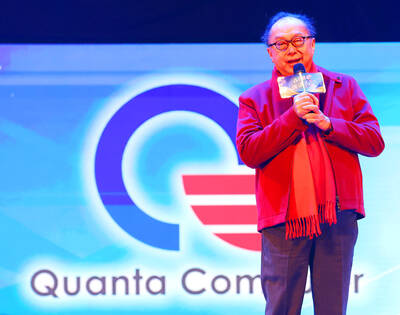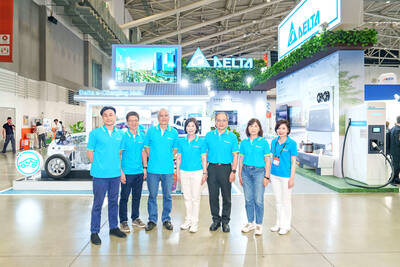US memorychip giant Micron Technology Inc yesterday said it was considering increasing DRAM assembly and testing manufacturing at its Taiwanese facility to help customers mitigate the consequences from punitive tariffs imposed by the US on some Chinese goods.
Micron made the remarks at a news conference following the ceremonial opening of its first advanced DRAM chip assembly and testing facility in Taichung.
Micron is to invest about NT$50 billion (US$1.61 billion) in the facility, the Central Taiwan Science Park (中部科學園區) administration said.
ADJUSTMENTS
“We are looking at the current issue. We are faced with the tariffs that the US levied against certain products from China,” Micron executive vice president of global operations Manish Bhatia told reporters.
DRAM modules, the final product of the DRAM assembly and test process, are to bear the brunt of the levies, Bhatia said.
Micron is making some adjustments to shield its customers from the levies, Bhatia said, adding that the chipmaker is using its global manufacturing footprint to alleviate any effects.
“Potentially, for assembly and testing, there are some aspects where we will be having more manufacturing in Taiwan,” Bhatia said.
Micron does not operate any DRAM or NAND wafer fabrication facilities in China, so there would be no changes to DRAM wafer manufacturing, he said.
Taiwan remains the largest DRAM manufacturing hub for the US company, with two fabs in Taoyuan and Taichung, he said.
Micron plans to increase its local headcount by 1,000 within a year, he said.
BIGGEST EMPLOYER
The chipmaker is the biggest foreign employer in Taiwan, with more than 7,000 employees, including 1,500 at the new chip assembly and testing fab.
Micron is to provide assembly and testing services for 3D ICs and high-bandwidth mobile DRAM used in flagship smartphones, as well as other high-value and leading-edge products.
The DRAM industry would remain structurally healthy over the longer term, given the increasing difficulty and capital-intensity of required technology transitions and greater diversity in DRAM applications, Bhatia said.
The Boise, Idaho-based chipmaker expects worldwide DRAM supply to grow about 20 percent next year and plans to match that pace with production growth.
The company said it plans to spend about US$10.5 billion on new manufacturing in fiscal 2019, which started last month, up from US$8.2 billion in the past fiscal year.
It would focus on technological transition, while maintaining existing wafer capacity, the chipmaker said.

Intel Corp chief executive officer Lip-Bu Tan (陳立武) is expected to meet with Taiwanese suppliers next month in conjunction with the opening of the Computex Taipei trade show, supply chain sources said on Monday. The visit, the first for Tan to Taiwan since assuming his new post last month, would be aimed at enhancing Intel’s ties with suppliers in Taiwan as he attempts to help turn around the struggling US chipmaker, the sources said. Tan is to hold a banquet to celebrate Intel’s 40-year presence in Taiwan before Computex opens on May 20 and invite dozens of Taiwanese suppliers to exchange views

Application-specific integrated circuit designer Faraday Technology Corp (智原) yesterday said that although revenue this quarter would decline 30 percent from last quarter, it retained its full-year forecast of revenue growth of 100 percent. The company attributed the quarterly drop to a slowdown in customers’ production of chips using Faraday’s advanced packaging technology. The company is still confident about its revenue growth this year, given its strong “design-win” — or the projects it won to help customers design their chips, Faraday president Steve Wang (王國雍) told an online earnings conference. “The design-win this year is better than we expected. We believe we will win

Quanta Computer Inc (廣達) chairman Barry Lam (林百里) is expected to share his views about the artificial intelligence (AI) industry’s prospects during his speech at the company’s 37th anniversary ceremony, as AI servers have become a new growth engine for the equipment manufacturing service provider. Lam’s speech is much anticipated, as Quanta has risen as one of the world’s major AI server suppliers. The company reported a 30 percent year-on-year growth in consolidated revenue to NT$1.41 trillion (US$43.35 billion) last year, thanks to fast-growing demand for servers, especially those with AI capabilities. The company told investors in November last year that

Power supply and electronic components maker Delta Electronics Inc (台達電) yesterday said it plans to ship its new 1 megawatt charging systems for electric trucks and buses in the first half of next year at the earliest. The new charging piles, which deliver up to 1 megawatt of charging power, are designed for heavy-duty electric vehicles, and support a maximum current of 1,500 amperes and output of 1,250 volts, Delta said in a news release. “If everything goes smoothly, we could begin shipping those new charging systems as early as in the first half of next year,” a company official said. The new